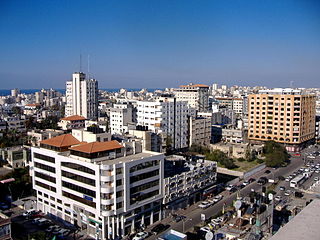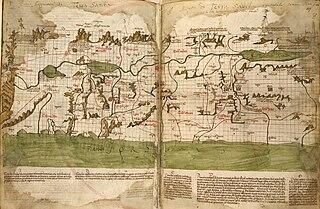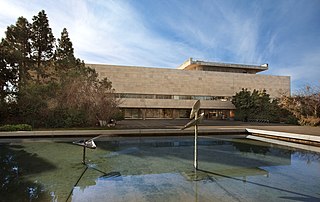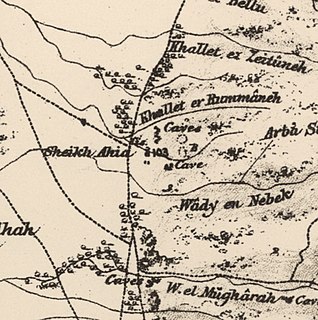Libraries in the Palestinian territories

This is a list of libraries in the Palestinian territories.

| Wikimedia Commons has media related to Libraries in the Palestinian territories . |

Gaza, also referred to as Gaza City, is a Palestinian city in the Gaza Strip, with a population of 590,481, making it the largest city in the State of Palestine. Inhabited since at least the 15th century BCE, Gaza has been dominated by several different peoples and empires throughout its history.

The Holy Land is an area roughly located between the Jordan River and the Mediterranean Sea that also includes the Eastern Bank of the Jordan River. Traditionally, it is synonymous both with the biblical Land of Israel and with the region of Palestine. The term "Holy Land" usually refers to a territory roughly corresponding to the modern State of Israel, the Palestinian territories, western Jordan, and parts of southern Lebanon and of southwestern Syria. Jews, Christians, and Muslims all regard it as holy.

Al-Qastal was a Palestinian village located eight kilometers west of Jerusalem named for a Crusader castle located on the hilltop. Used as a military base by the Army of the Holy War, the village was captured by the Palmach in the lead up to the Arab-Israeli War and depopulated of its residents.

al-Nahr, was a Palestinian village 14 km (8.7 mi) northeast of Acre. It was depopulated in May 1948 after a military assault carried out by the Carmeli Brigade as part of the Israel Defense Forces's Operation Ben-Ami. Immediately after the assault, the village of al-Nahr was razed.

Khirbat Jiddin, known in the Kingdom of Jerusalem as Judin, was an Ottoman fortress in the western Upper Galilee, originally built by the Teutonic Order after 1220 as a crusader castle, 16 km northeast of the city of Acre, which at the time was the capital of the Kingdom of Jerusalem. The castle was destroyed by the Mamluk sultan Baibars sometime between 1268-1271 and lay in ruins until being rebuilt and expanded by the Arab ruler Zahir al-Umar as Qal'at Jiddin in the 1760s, only to be destroyed again around 1775 by Jazzar Pasha. The ruined fortress, known as Khirbat Jiddin, was later inhabited by the al-Suwaytat Bedouin tribe.

Al-Sumayriyya, was a Palestinian village located six kilometers north of Acre that was depopulated after it was captured by the Israel Defense Forces during the 1948 Arab-Israeli War.

Al-Tall, was a Palestinian village 14 km northeast of Acre in the British Mandate District of Acre. Depopulated as a result of military assault and capture during the 1947-1948 Civil War in Mandatory Palestine as part of Operation Operation Ben-Ami by the Carmeli Brigade of the Israel Defense Forces.

Al-Damun, was a Palestinian Arab village located 11.5 kilometres (7.1 mi) from the city of Acre that was depopulated during 1948 Arab-Israeli war. In 1945, the village had 1,310 inhabitants, most of whom were Muslim and the remainder Christians. Al-Damun bordered the al-Na'amin River, which the village's inhabitants used as a source of irrigation and drinking water from installed wells.

Al-Khisas, also known as Khisas or Khissas, was a Palestinian Arab village in the Safad Subdistrict in Mandatory Palestine. It was located 31 kilometers (19 mi) northeast of Safed on a natural terrace about 100 meters (330 ft) wide that formed when Lake al-Hula receded. To the west of the village was a valley known as Wadi al-Hasibani through which ran the Hasbani River.

The Institute for Palestine Studies (IPS) is the oldest independent nonprofit public service research institute in the Arab world. It was established and incorporated in Beirut, Lebanon, in 1963 and has since served as a model for other such institutes in the region. It is the only institute in the world solely concerned with analyzing and documenting Palestinian affairs and the Arab–Israeli conflict. It also publishes scholarly journals and has published over 600 books, monographs, and documentary collections in English, Arabic and French—as well as its renowned quarterly academic journals: Journal of Palestine Studies, Jerusalem Quarterly, and Majallat al-Dirasat al-Filistiniyyah. IPS's Library in Beirut is the largest in the Arab world specializing in Palestinian affairs, the Arab–Israeli conflict, and Judaica.

The National Library of Israel, formerly Jewish National and University Library, is the library dedicated to collecting the cultural treasures of Israel and of Jewish heritage. The library holds more than 5 million books, and is located on the Givat Ram campus of the Hebrew University of Jerusalem.

Al-Mazar was a Palestinian Arab village located 4 kilometers (2.5 mi) northeast of al-Sarafand. In 1945, it had a population of 210.

Allar or 'Allar el-Fawqa, also known as 'Allar el Busl, was a Palestinian Arab village located southwest of the Old City of Jerusalem near Wadi Surar, along Wadi Tannur. The name was shared by the twin village of Allar al-Sifla or Khirbat al-Tannur, with official imperial ledgers often listing them both under the single entry of Allar.

Al-Burayj was a Palestinian Arab village in the Jerusalem Subdistrict. It was depopulated during the 1948 Arab–Israeli War on October 19, 1948, during the first phase of Operation Ha-Har. The village was located 28.5 km west of Jerusalem.

Mughr al-Khayt was a Palestinian Arab village in the Safad Subdistrict. It was depopulated during the 1947–1948 Civil War in Mandatory Palestine on May 2, 1948 by the Palmach's First Battalion of Operation Yiftach. It was located 4.5 km northeast of Safad. In 1945 it had a population of 490 Muslims.

Al-Zahiriyya al-Tahta was a Palestinian Arab village in the Safad Subdistrict. The village was on a descent at the southwestern part of Safad, a town 1 kilometer (0.62 mi) east of the village. Possibly named after the Mamluk sultan al-Zahir Baybars, the village was incorporated into the Safad Sanjak of the Ottoman Empire in 1517, and its entirely Muslim population paid fixed taxes, as well as taxes on winter pastures, an olive oil or grape syrup press and beehives during the 16th century. By the late 19th century, the population grew to 335 inhabitants, all Muslims. The population remained about the same in the last years of British Mandatory rule. The village lands spanned 6,773 dunums, nearly half of which were used to grow grains, the residents living on 28 dunums. Al-Zahiriyya al-Tahta was depopulated during the 1948 Palestine War when its inhabitants fled shortly after the capture of Safed by Jewish paramilitary forces.

Al-Sammu'i was a Palestinian Arab village in the Safad Subdistrict. It was depopulated during the 1947–1948 Civil War in Mandatory Palestine on May 12, 1948, under Operation Hiram. It was located 4 km west of Safad. Today, Kfar Shamai is built on the site of the old village, and Amirim is built on the southern part of the village land.

Al-'Ubaydiyya was a Palestinian Arab village in the Tiberias Subdistrict. It was depopulated during the 1947–1948 Civil War in Mandatory Palestine on March 3, 1948. It was located 11 km south of Tiberias, situated close to the Jordan River.